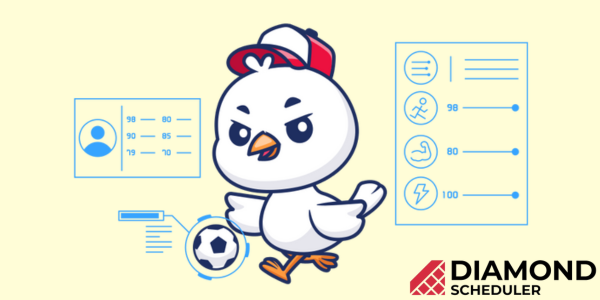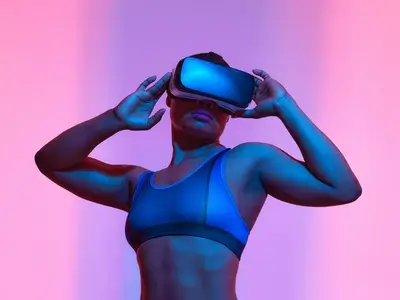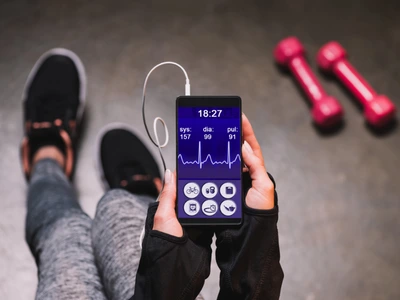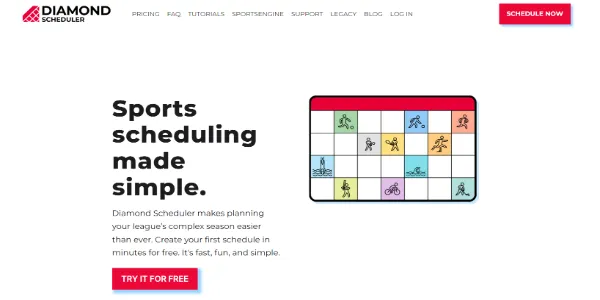
Sports Technology That’s Revolutionizing Sports in 2024
Technology in the sports industry is changing rapidly.
In the past decade, developments in the sports industry have rolled out season after season, changing the topography of athletics as we know it.
These innovations not only affect sports fans but also rule enforcers, professional athletes, coaches, and other supporting athletic staff members.
The release of new technology is game-changing, from scorekeeping developments, data analytics, and television tech to sports medicine and injury prevention, it's safe to say that sports technology is here to stay.
This article will break down some of the recent technological shifts in the sports industry, giving you the inside scoop on all things innovative.
What is sports technology?

Sports technology refers to technologies that are developed to optimize human interaction and athletic performance within the world of sports.
This could be anything from technical attempts to improve athlete training and performance to systems that help referees make more precise calls out on the field. One of the best examples is the electronic pitch calling system in baseball that offers coach and players on-field communication at all times.
Ultimately, technological advancements in sports are meant to push the sports tech industry further into optimization.
Some of the more common sports technology products include wearable technology, data tracking and data collection, sports injury prevention, event scheduling, goal-line technology, video analysis and virtual reality.
How is sports tech changing the industry?
Sports technology has drastically advanced the sports entertainment industry over the past decade and only has an upward trajectory from here.
1. Sports tech enhances the viewing experience
Development in televised sports has enhanced the experience for sports fans, giving viewers real-time on-screen data analytics, referee calls, replays, and sports commentary, no matter if fans are sitting in the front row or their couch.
You no longer have to be physically present at a sporting event to feel like you're on the sidelines.
2. Sports tech helps prevent and diagnose injuries
Advancements in sports injury diagnostics have allowed medical professionals in the sports industry to evaluate athletes quicker to get them back on the field as soon as possible.
Better yet, this new technology has allowed trainers and coaches to prevent injuries from happening in the first place! The trainer career has witnessed a significant boost with the integration of these cutting-edge tools.
These new gadgets have supported and advanced research that has helped trainers develop preventative care for their athletes.
From heart rate monitors to training plans and recovery systems, athlete health has improved, leading to fewer injuries.
3. Sports tech keeps games fair
Various diagnostic and analytic data-gathering devices have been created to help with sideline decision-making, from referee tools to playback technology.
Emerging camera technology and video tracking enable referees to make more precise calls.
This makes gameplay more fair and equitable, removing human error from the equation. Understanding the average cost of app development is crucial for sports organizations looking to integrate advanced technologies into their operations, ensuring they can budget effectively for innovative solutions that enhance both athlete performance and fan engagement.
Some sports technology has become widely available and is not solely reserved for elite athletes.
Let's take a closer look at some of the specific ways that sports technology has changed the industry on the field, court, and track.
4. Sports tech enhances operational efficiency
Beyond improving athlete performance and fan engagement, sports technology plays a crucial role in streamlining the operational aspects of sports organizations.
Implementing advanced cloud and DevOps solutions can lead to more efficient management of digital platforms, ensuring seamless delivery of content and services to fans and stakeholders. For instance, companies like OpSourced specialize in providing cloud and DevOps expertise, helping sports organizations optimize their.
How has wearable sports tech impacted athletes?

Wearable technology is sports tech that can be worn on the wrist, ankle, or other parts of the body to measure performance. This technology is especially useful for those combining it with treadmill workouts for losing weight, as it can provide detailed metrics to optimize their exercise routines
We'll cover a few wearable sports tech options below.
1. Fitness watches track performance
The most common type of wearable technology is the fitness watch.
Professional athletes and amateurs alike use fitness watches to track measurable statistics such as their heart rate, calories burned, step count, running distances, and pace.
Fitness watches are great for beginners and elite athletes to track their progress and meet their fitness goals.
2. Heart rate monitors track heart responses
Heart rate monitors are another type of wearable technology that tracks the heart rate of an athlete (and pulmonary activity).
This data can be helpful in researching an athlete's target heart rate during exercise, fitness level, and heart health.
Heart rate monitors can also be used to detect cardiovascular irregularities and prevent overtraining.
3. Sports helmets are used for communication and protection
Helmets are also considered wearables and are useful in goalie positions or sports like American football.
Helmets often have built-in headsets and/or video capabilities that allow communication between athletes and their support team for more fluid performance and execution.
Over the decades, helmet technology and other football equipments has also developed to make the gear more protective in order to prevent injuries such as concussions.
Read More: Football Schedule Generator. We show you step-by-step how to use a schedule generator for football!
How are data tracking and collection tech used in sports?

There are dozens of ways that researchers in exercise science can collect data about athletic performance and an athlete's health.
The primary way that this type of data is collected is through sensors.
Sensors are worn by athletes or embedded in their clothing or shoes.
Sports-specific sensors are made for personalized data analytics and insights for optimal athletic performance.
Let's look at a few types of data-tracking tools used in exercise science research.
1. GPS sensors track movement
Global Positioning System (GPS) sensors can track location, speed, and other movement-based metrics for outdoor activities like running or cycling.
2. VBT sensors track performance
Velocity Based Training (VBT) sensors can be used to track the performance of weight lifters.
3. Sleep tracking devices monitor sleep quality
Sleep tracking apps and devices monitor sleep and can help athletes reach sleep goals for athletic performance and recovery.
There are even different sensors that can help sports medicine professionals aid athletes in preventing injuries.
How has technology advanced sports injury prevention?

Injury prevention has been a driving force behind the development of new sports technologies.
Sports injuries can be devastating for an athlete and can even end their career.
Prevention is key to keeping teams healthy and performing at the highest level.
Let's look at some of the latest advancements in sports medicine.
1. Mouthguards monitor impacts
High-tech mouthguards have been created with built-in sensors that can notify an athlete of when it may be time to take a breather.
Mouth guards light up after a head impact, glowing red for devastating blows or blue for medium-degree impacts.
2. Helmets prevent head injuries
High-tech helmets are outfitted with features such as shock absorption to protect an athlete's head during impact.
These are created to resemble airbags in a car and release air to reduce the whiplash effect that an athlete may experience in the event of head trauma.
3. Diagnostic programs help identify high-risk players
Some diagnostic programs are in the works to help athletes prevent injuries through the use of biometric data.
This can help single out athletes that may be at a higher risk of injury than others on a team.
Using high-definition cameras and computer generation, players and coaches can view analyzed data to make changes and prevent injuries before they even occur.
Online event scheduling simplifies gamedays and events

Schedule generators are another example of sports technology that has changed how teams, sports organizations, and athletes plan and attend athletic events.
One example of this is the Diamond Scheduler program.
This application makes planning a league's complex season much easier, reducing the possibility of improper scheduling or redundant schedule constraints and conflicts.
Having a season laid out properly makes life simpler and more organized for coaches, players, and fans alike.
Event scheduling technology negates the need for mass email outreach with schedule corrections or hours at the drawing board.
Whether you are the coach for a volunteer softball team or the team manager for a professional league, software like Diamond Scheduler can take on the heavy lifting of managing events.
What is GLT (Goal Line Technology) and how has it changed sports?
Sensors and digital monitoring software can be used at the goal line to determine whether or not goals are valid.
Sometimes, the naked eye can't distinguish between a ball fully crossing a goal line or not.
This could be a game-winning or game-losing call, which is a lot of pressure for a referee to shoulder on their own.
This electronic aid can step in and determine, for example, whether the football fully crossed the goal line or not.
Most goal line technology either uses strategically-placed cameras or magnetic fields to track the ball and determine its movements in relation to the goal line.
Visual indicator technology, such as GLT, removes the potential for human error.
Goal line technology has contributed to more accurate games and less wiggle room for cheating.
How has virtual reality shaped the world of sports tech?
A mixture of virtual reality, augmented reality, and mixed reality systems help to prepare players for real game-time scenarios.
Virtual reality environments are closely monitored and realistic, allowing players to compete at their normal performance level with less chance of injuries.
Virtual reality has already been implemented in the training of top athletes.
For example, virtual reality is used as a tool for golfers to perfect their swing and for goalies to develop their reaction speed and cultivate their decision-making skills.
VR has even been involved in concussion protocols, reducing the likelihood of head impacts taking place in training sessions.
Virtual reality cannot replace training entirely, but it does provide a safe option for athletes to practice proper techniques.
Watch the video below to see how virtual reality is used in baseball training:
What is VAR (Video Assistant Referee) and how is it used in sports?
VAR debuted during the FIFA World Cup in 2018, and the industry has changed ever since.
First impacting game calling in the World Cup arena, VAR has since been adopted by other leagues, including the Premier League, as a tool to promote fairness and discourage cheating.
This system is equipped with high-quality camera technology, making refereeing more precise and less affected by flawed elements like human error.
With video replay systems in conjunction with the VAR setup, a team of referees in an on-site control room can evaluate each play and correct any missed calls.
Technology like this makes games fairer and equitable for both teams involved.
How does cognitive training technology benefit athletes?
Being a top athlete is not only a measure of physical toughness but of mental toughness.
In recent years, there has been a shift in the world of sports that has given more attention and care to other elements of an athlete beyond how fast they can run or how much weight they can lift.
Cognitive exercises combine technological advances with simple phenomena like hand-eye coordination and reaction times.
This bridge between mental and physical performance is a big deal for athletes and is a surefire way to help athletes reach their highest potential.
How does instant replay impact games?
Instant replays have changed the way sports are watched and refereed.
Sports officials can use instant replay to evaluate calls made during a game and even slow the video down for closer examination.
This technology has helped officials make more informed decisions and created all kinds of uproars between fans, coaches, and referees.
How has digital fan engagement changed sports?
Sports organizations have developed ways to make sports more engaging for fans who can't attend games in person.
From loyalty programs to high-tech rewards, fan engagement is meant to help fans feel more involved.
Outside of the arena, community-building forums, fantasy leagues, and fan clubs give viewers easy access to news about their favorite teams.
At its roots, waving a foam finger or a sports jersey was the extent to which fans could show diehard support for a team.
Now, fan engagement has never been more involved and connected than with these digital tools.
What are hawk-eye sensors and how do they affect gameplay?
Hawk-eye sensors have made gameplay and evaluation of match outcomes more informed through ball tracking and statistical diagnostics.
This tool uses varying visual sensors to analyze the trajectory of a ball and display its most-likely path during a game.
Hawk-eye sensors are often used in sports like cricket, tennis, badminton, and volleyball.
An example of hawk-eye technology in action is determining whether or not a bat smashed a cricket ball before it was caught.
Another application of this would be tracking the trajectory of where a soccer ball would have landed if it didn't hit a player's foot.
Conclusion
Sports technology has exponentially expanded the sports business and made resources more easily accessible to fans, coaches, athletes, and sports medicine teams alike.
Things can only go up from here, and we are excited to see how new innovations continue to grow, improve athletic performance, and decrease career-ending injuries.
Thalia Oosthuizen has been writing in a professional capacity for over a decade. Her love for sports has led her down the path of sports writing, where her passion and skills combine. Thalia is a runner, cyclist, and swimmer, and enjoys playing tennis and hockey. Her favorite sports teams include Chelsea F.C. and the Georgian Lions Rugby Club.



